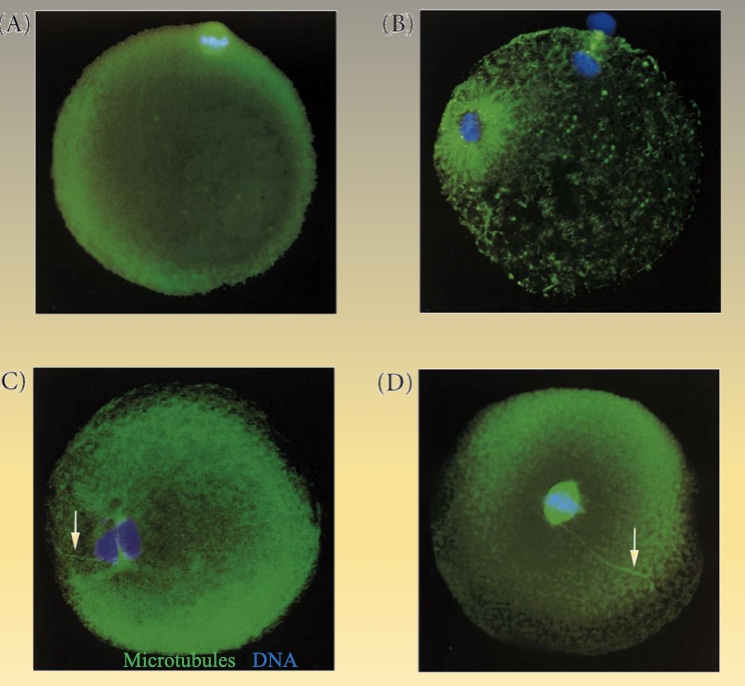CHAPTER 7: FERTILIZATION
1/12
There's no tags or description
Looks like no tags are added yet.
Name | Mastery | Learn | Test | Matching | Spaced |
|---|
No study sessions yet.
13 Terms
What are the key structures and functions of sperm cells
The acrosome contains enzymes that help digest and penetrate the egg’s outer layers.
The sperm eliminates most of their cytoplasm and primarily functions to transmit their haploid nucleus (male pronucleus) to the egg.
In many animals, sperm also contribute to a centriole.
Movement is driven by a flagellum, which contains an axoneme that is made of tubulin and dynein; dynein uses ATP (energy) from mitochondria at the flagellum's base.
The LINC protein links the acrosome, nucleus, and flagellum together. (think of it as a binding trait)
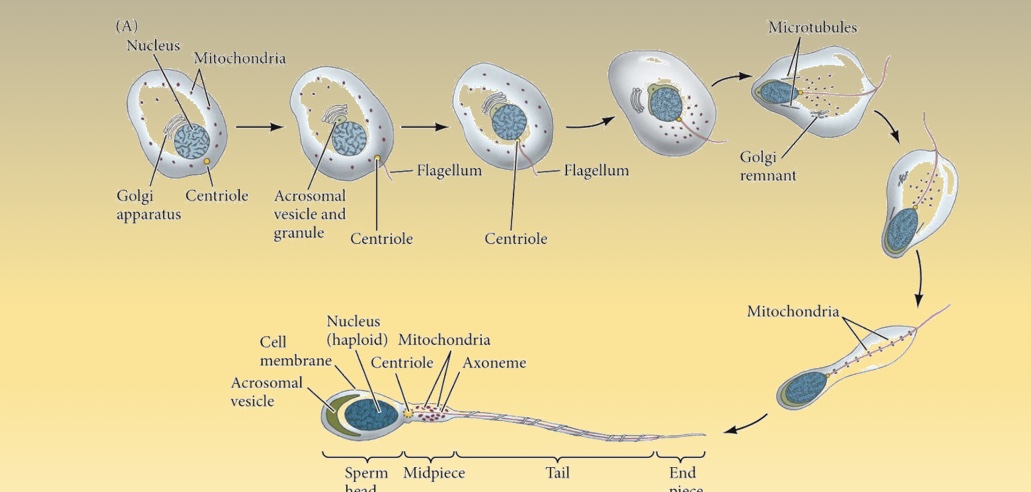
What key materials does the egg contain for early development?
Nutritive Proteins (energy and amino acids)
Ribosomes & tRNA (for protein synthesis)
mRNA (stored and repressed until after fertilization)
Morphogenetic factors (guide cell differentiation)
Protective chemicals (UV filters, bad-tasting molecules, antibodies)
In many species, sperm entry occurs before the egg completes meiosis; in most mammals (including humans), this happens at metaphase II.
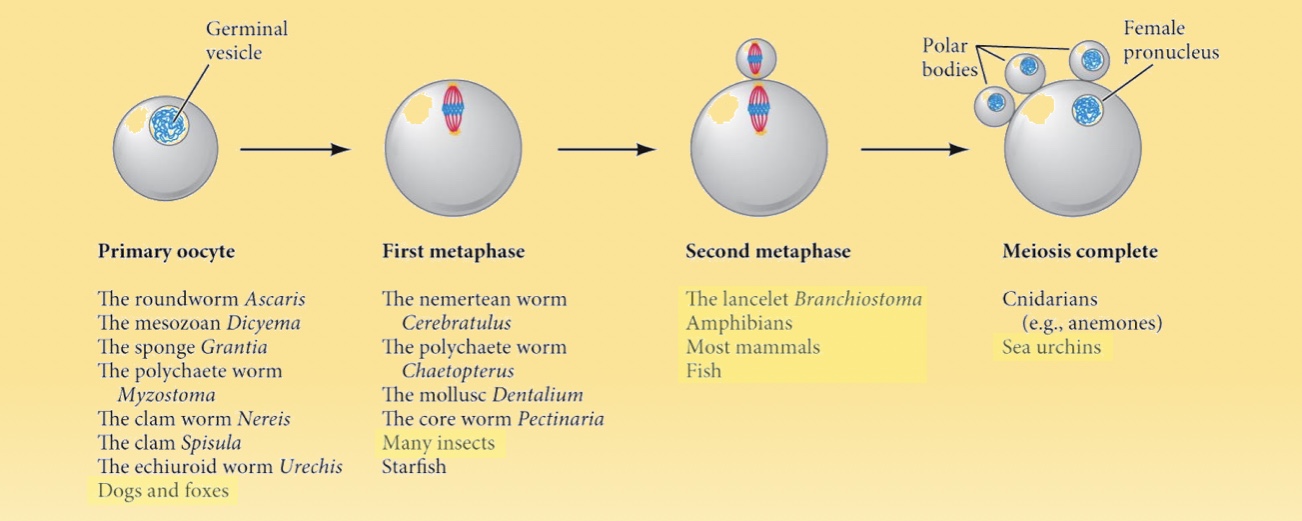
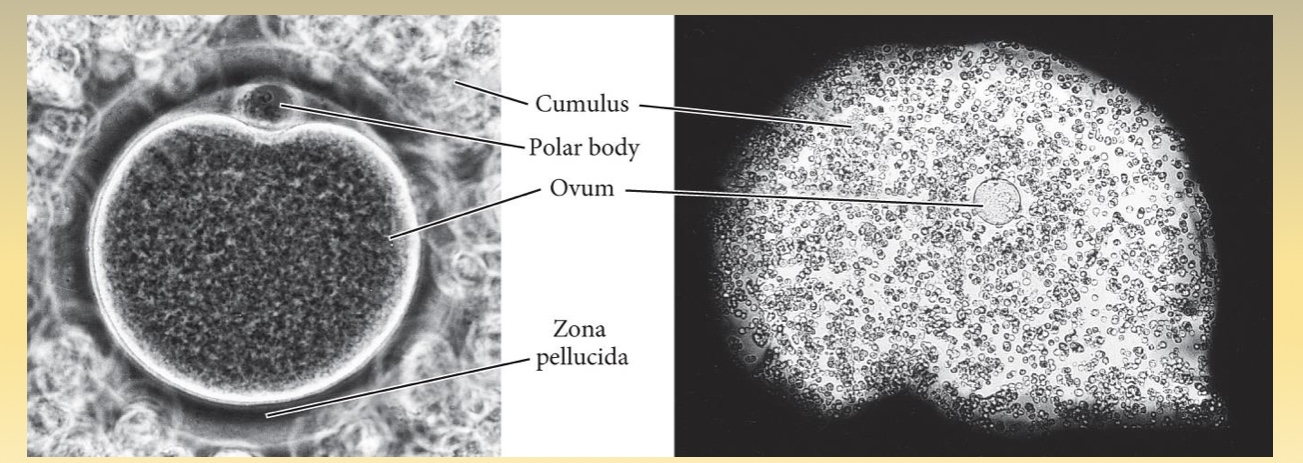
What structures of the egg are involved in sperm recognition and fusion?
The extracellular matrix: (vitelline envelope in invertebrates, zona pellucida + cumulus cells in mammals) is crucial for sperm-egg recognition. It forms a fibrous mat around the egg.
The egg cortex: contains microvilli with actin microfilaments and cortical granules with digestive enzymes
Many invertebrate eggs have an external jelly layer that attracts or activates sperm.( vitelline envelope)
What are the key steps in egg-sperm recognition and fusion?
Chemoattraction – Sperm are attracted by soluble molecules secreted by the egg.
Acrosome reaction – The sperm releases enzymes via exocytosis of the acrosome.
Sperm binding – Sperm binds to the vitelline envelope (invertebrates) or zona pellucida (mammals).
Penetration – Sperm passes through the vitelline envelope or zona pellucida.
Membrane fusion – The plasma membranes of the sperm and egg fuse.
4o
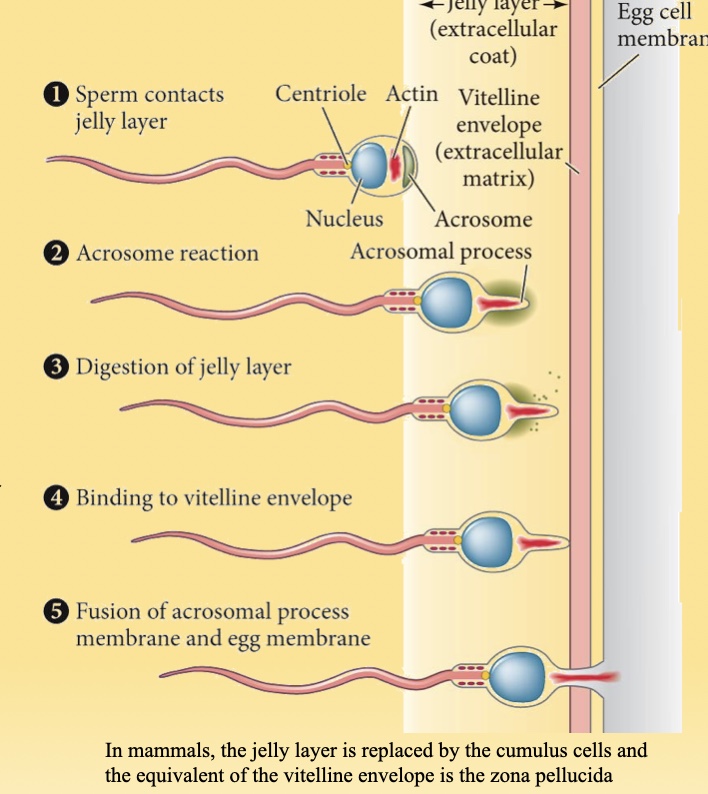
How do the egg and sperm reach the site of fertilization in mammals?
egg and sperm translocation!!!
Fertilization occurs in the ampulla of the oviduct.
Egg translocation: The fibriae recognize the ECM of cumulus cells and pick up the oocyte-cumulus complex. Cilia and muscle contractions move toward the ampulla
Sperm translocation:
Motility (flagellum activity) helps sperm enter the uterus.
Uterine muscle contractions move sperm to the oviduct, where they slow down. (found in mice, hamsters, guinea pigs, cows, and humans within 30 mins of sperm deposition in the vagina)
Sperm rheotaxis: swims against the flow (rheotaxis) of liquid moving from the ampulla to the uterus.
Sperm mature along this journey.
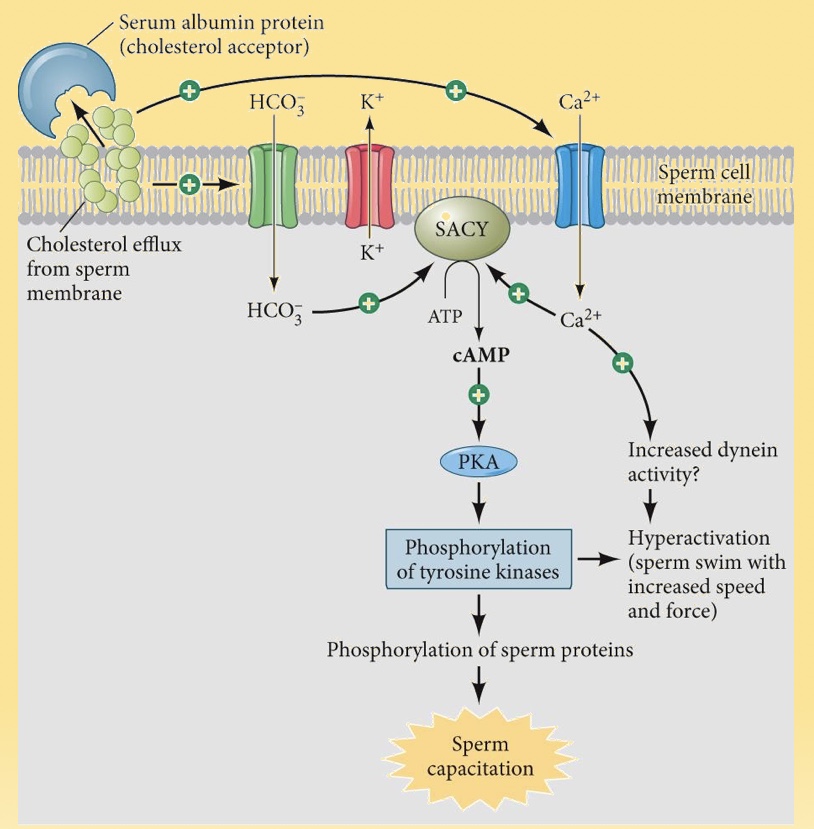
What is sperm capacitation and why is it important? (how does it work?)
a process that occurs ONLY IN the female reproductive tract, making sperm capable of fertilizing the egg. It begins with the removal of cholesterol from the sperm's plasma membrane. Capacitated sperm gain:
Ability to follow signals from the egg.
Ability to undergo the acrosome reaction.
Ability to fuse with the egg membrane.
How does capacitation affect sperm movement and lifespan?
Capacitation is a process that helps sperm get ready to fertilize an egg. It may happen when sperm touch the lining of the oviduct (specifically the isthmus), which also helps them live longer.
At the end of capacitation, sperm becomes hyperactivated—they swim faster and with more force. This helps them break free from the oviduct lining. They also move toward warmer temperatures, following a 2°C difference from the cooler isthmus to the warmer ampulla, where fertilization takes place.
What signals guide sperm toward the egg and trigger the acrosome reaction? (concept of capacitation)
Capacitated sperm can sense very tiny amounts of progesterone, a hormone released by the cells around the egg (cumulus cells). This hormone causes the sperm to swim harder (hyperactivate) and turns on a special calcium channel called CatSper. The calcium ions boost the sperm’s energy by charging its mitochondria.
As the sperm gets closer to the egg, the high calcium levels also trigger the acrosome reaction, which helps the sperm break through the egg’s outer layers.

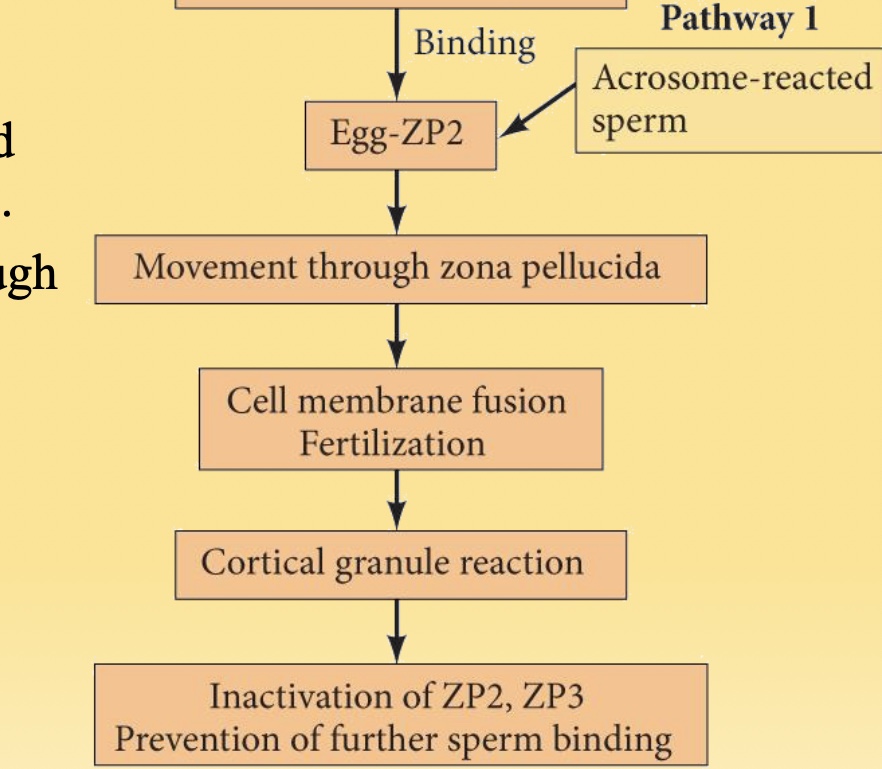
How does sperm interact with the zona pellucida during fertilization? (contact recognition)
During fertilization, the acrosome reaction occurs when the sperm enters the cumulus.
The zona pellucida contains glycoproteins: ZP1, ZP2, and ZP3 in mice, and an additional ZP4 in humans.
Sperm that have undergone the acrosome reaction bind to ZP2.
Unreacted sperm bind to ZP3, undergo the acrosome reaction, and then bind to ZP2.
The release of acrosome enzymes helps the sperm digest a path through the zona pellucida, allowing it to reach the egg membrane.

What proteins are involved in gamete fusion during fertilization?
Gamete fusion occurs at the equatorial region of the sperm and relies on the sperm protein Izumo, which binds to the oocyte protein Juno. This interaction recruits other oocyte proteins necessary for the fusion of the sperm and egg membranes.
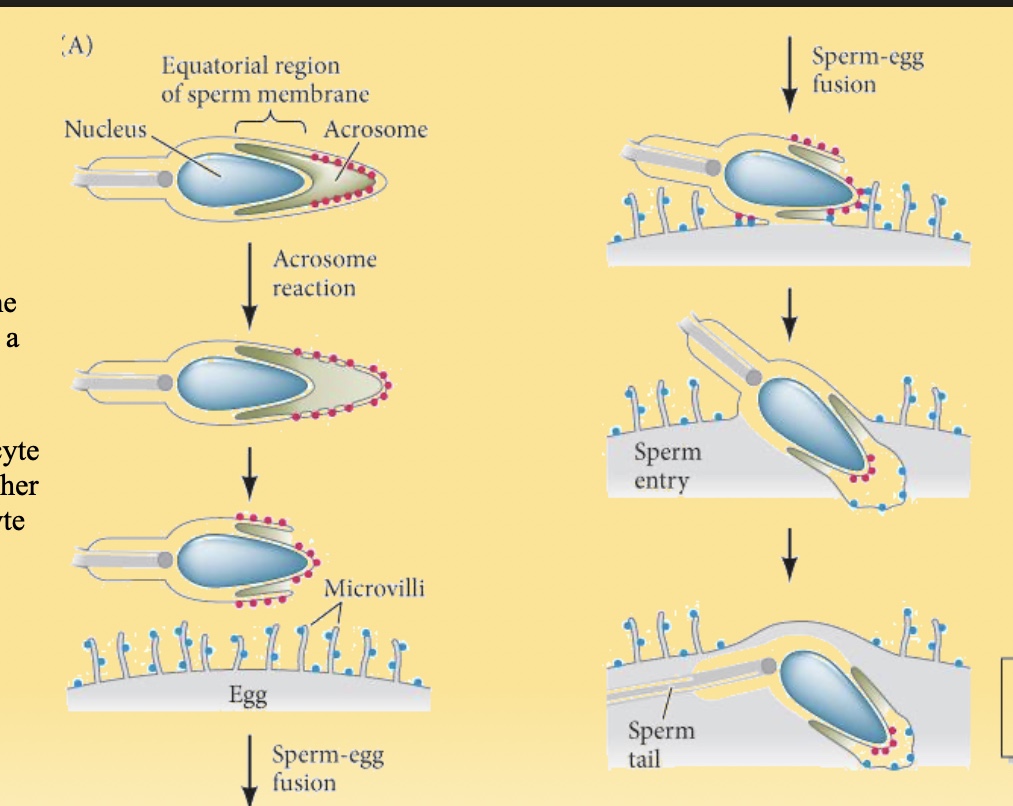
How is polyspermy prevented during fertilization?
fast and slow block!!
Fast block: In sea urchins, the membrane potential changes from negative to positive after the first sperm enters, preventing further sperm entry. Mammals do not have a fast block.
The slow block stops more than one sperm from entering the egg after fertilization:
A rise in calcium inside the egg triggers the cortical granule reaction, which releases enzymes (like ovostacin) that cut ZP2, a protein sperm need to bind to the egg.
The egg also releases a burst of zinc ions (called a zinc spark) that block enzymes sperm need for capacitation and the acrosome reaction.
A protein called Juno is removed from the egg’s surface, so no more sperm can fuse with the egg membrane.

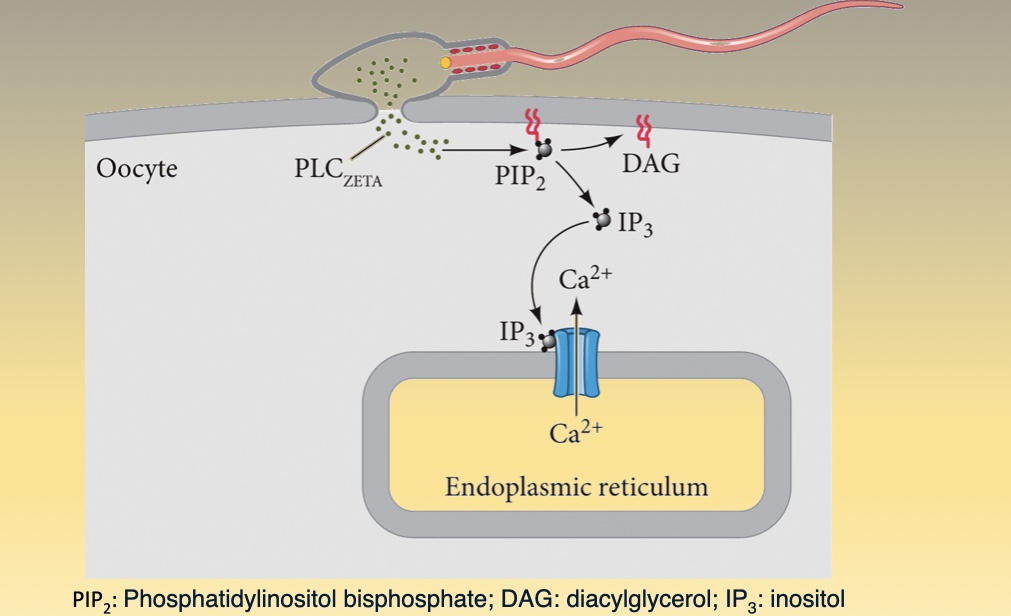
What happens during the fusion of genetic material and activation of the egg?
The DNA from both the sperm and egg pronuclei loses most of its chemical tags (demethylation), erasing old epigenetic marks.
The sperm releases an enzyme called PLCζ (phospholipase C-zeta), which creates IP3 (inositol triphosphate).
IP3 triggers calcium (Ca²⁺) waves in the egg, which cause:
The cortical reaction (to block more sperm)
Meiosis to restart and finish
Activation of stored mRNA (so the egg can start making proteins)
Beginning of DNA replication to prepare for cell division
How do the pronuclei come together after fertilization?
The sperm centriole organizes an aster of microtubules that helps bring the two pronuclei together. As they approach, the nuclear envelopes of both pronuclei break down, allowing the first mitosis to begin.
